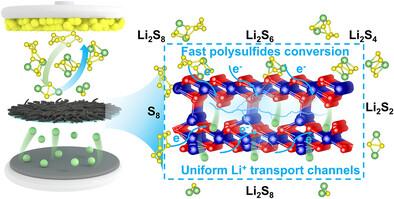Interfacial Build-In Electric Field Unlocking Hetero-Architectured CoO-Co3O4 Nanotubes Toward High-Performance Li-S Batteries
IF 19
1区 材料科学
Q1 CHEMISTRY, MULTIDISCIPLINARY
引用次数: 0
Abstract
The sluggish redox kinetics and intrinsic dissolution of lithium polysulfides (LiPSs) critically hinder the desirable commercialization of Li-S batteries (LSBs). Purposeful modification of separators with multi-functional materials brings enormous room for both efficiently restraining the dissolution and enhancing the solid-liquid-solid conversion kinetics of LiPSs. For this, herein, hetero-architectured CoO-Co3O4 hollow nanotubes (HNTs) are elaborately designed and fabricated via a self-sacrifice template methodology to modify the polypropylene (PP) separator for advanced LSBs. Besides the robust physico chemical adsorption, the endogenous CoO-Co3O4 heterojunction, as authenticated by theoretical calculations and experimental verification, spontaneously creates an interfacial built-in electric field, which simultaneously enhances the active sites, accelerates the bi-directional sulfur conversion, and favors the fast electron/ion transport. Thanks to successful realization of the synergistic “electrostatic capture-energy barrier regulation-directional conversion” effect, LSBs with the hetero CoO-Co3O4 HNTs modified PP separator exhibit significantly improved electrochemical performance with the long-duration cycling stability for 1000 cycles at 5 C, and a large capacity of 631.5 mAh g−1 even at a high sulfur loading (5 mg cm‒2) and low electrolyte/sulfur ratio (8.0 µL mg−1). More essentially, our contribution here offers a viable avenue for up-and-coming hetero-catalyst functionalized separator platforms toward next-generation LSBs and beyond.

界面内置电场解锁异质结构co - co3o4纳米管,用于高性能锂- s电池
多硫化锂(LiPSs)缓慢的氧化还原动力学和固有溶解严重阻碍了Li-S电池(LSBs)的商业化。利用多功能材料对分离剂进行有针对性的改性,为有效抑制LiPSs的溶解和提高其固-液-固转化动力学提供了巨大的空间。为此,本文通过自我牺牲模板方法精心设计和制备了异质结构co - co3o4空心纳米管(HNTs),以修饰先进lbs的聚丙烯(PP)分离器。内源性co - co3o4异质结除了具有强大的物理化学吸附作用外,经理论计算和实验验证,该异质结自发形成界面内置电场,同时增强了活性位点,加速了硫的双向转化,有利于电子/离子的快速传递。由于成功实现了“静电捕获-能量势位能调节-定向转换”的协同效应,具有异CoO-Co3O4 HNTs改性PP分离器的lsb具有显著改善的电化学性能,在5℃下具有1000次循环的长时间稳定性,即使在高硫负荷(5 mg cm-2)和低电解质/硫比(8.0 μ L mg - 1)下也具有631.5 mAh g- 1的大容量。更重要的是,我们在这里的贡献为未来的杂化催化剂功能化分离平台提供了一条可行的途径,可以用于下一代lsb及其他领域。
本文章由计算机程序翻译,如有差异,请以英文原文为准。
求助全文
约1分钟内获得全文
求助全文
来源期刊

Advanced Functional Materials
工程技术-材料科学:综合
CiteScore
29.50
自引率
4.20%
发文量
2086
审稿时长
2.1 months
期刊介绍:
Firmly established as a top-tier materials science journal, Advanced Functional Materials reports breakthrough research in all aspects of materials science, including nanotechnology, chemistry, physics, and biology every week.
Advanced Functional Materials is known for its rapid and fair peer review, quality content, and high impact, making it the first choice of the international materials science community.
 求助内容:
求助内容: 应助结果提醒方式:
应助结果提醒方式:


